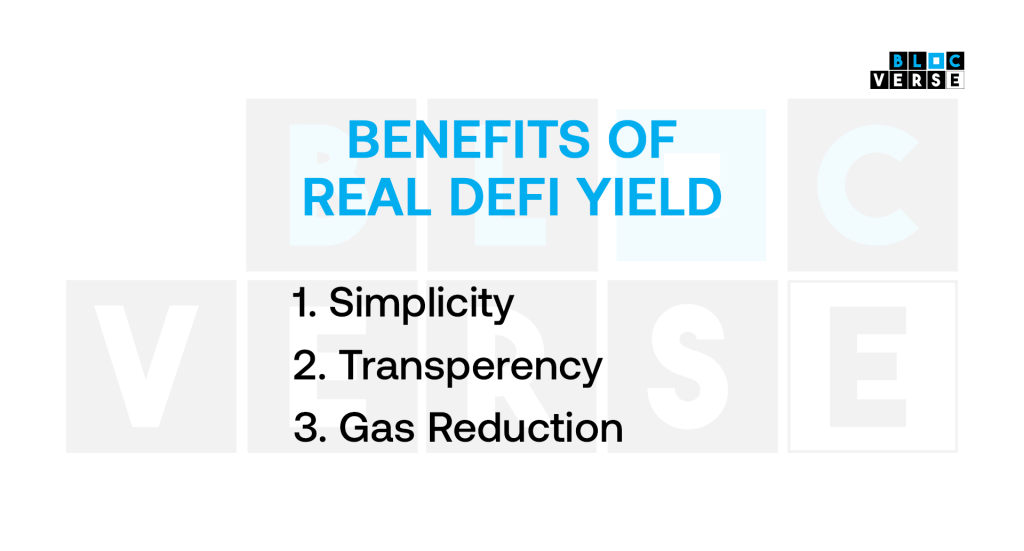INTRODUCTION
Decentralised finance (DeFi) has shifted the paradigm in traditional financial systems.
With DeFi, anyone with an internet connection can access financial services without intermediaries such as banks or brokerage firms.
One of the most significant advantages of DeFi is the opportunity to earn passive income through various yield farming strategies. One such method that is gaining popularity is Real Defi Yield.
Many DeFi projects offer high returns on investment, but it’s essential to evaluate the underlying fundamentals of the protocol to determine whether these yields are sustainable.
High yields may seem attractive initially, but they can be a red flag indicating that the protocol is engaging in risky or unsustainable practices.
However, not all DeFi yields are created equal, and the sustainability of the yield generated is a crucial factor to consider.
This article examines and discusses the importance of real yield in the DeFi realm.
TABLE OF CONTENTS
WHAT IS REAL DEFI YIELD IN DEFI?
Real Defi Yield (RDY) is a yield aggregator that provides a new way to earn passive income through DeFi.
It is a unique protocol that aims to maximise yield while minimising risks. The protocol leverages different yield farming strategies to generate the highest possible yield for users.
RDY provides users with a single platform that pools resources from multiple yield farming protocols, optimising returns while minimising gas fees.
HOW DOES REAL DEFI YIELD WORK?
Real Defi Yield aggregates yield farming strategies from DeFi protocols such as Compound, Aave, and Curve.
The platform’s smart contract then executes transactions on these protocols based on real-time market data and user input.
Users can deposit their tokens into RDY, automatically allocating them to the most profitable yield farming strategies.
Users can then withdraw their tokens at any time, along with their accrued interest.
RDY’s smart contract monitors and adjusts the portfolio’s allocation based on current market conditions, optimising the yield while minimising risks.
This approach ensures that users get the best possible returns while reducing the risks associated with yield farming.
THE GROWTH OF REAL YIELD
DeFi protocols resorted to unsustainable token emissions to fund high returns, increasing inflation.
Users were compensated with native tokens with limited use cases, commonly called “useless governance tokens.”
Protocols that utilised this bootstrapping strategy experienced short-term success, but many found it unsustainable in the long run.
Token demand often fails to keep pace with new emissions due to high emission schedules, resulting in hyperinflationary conditions.
Furthermore, demand for these tokens declined due to their limited utility, causing prices to plummet.
DeFi yield farmers frequently switched between protocols to maximise returns, with many immediately selling off governance tokens for profit.
As a result, DeFi projects had to explore new strategies, leading to the emergence of actual DeFi yield.
BENEFITS OF REAL DEFI YIELD

The following are significant benefits of real DeFi yield.
Simplicity
Users only need to deposit their tokens; the protocol handles the rest.
Transparency
Additionally, the platform provides transparency, allowing users to track their earnings in real time.
Unlike other yield farming strategies, real DeFi yield minimises risks, diversifying users’ portfolios across different DeFi protocols.
Gas Fees Reduction
Another advantage of Real Defi Yield is that it reduces gas fees.
Yield farming can be costly due to high gas fees, but real DeFi yield minimises these costs by aggregating resources from multiple protocols.
This approach reduces the gas fees associated with each transaction.
DEFI PROTOCOLS THAT PAY REAL YIELD
GMX
GMX is a DeFi protocol offering real yield opportunities through its AMM platform.
Its unique revenue-sharing model, based on two native tokens – GLP and GMX – has led to high liquidity and trading volume growth.
GMX tokens can be staked for 14% APR, while holding GLP tokens offers 28% APR, with boosted yield for vesting periods.
Despite the bear market, GMX’s governance token approached its all-time high due to the platform’s strong product-market fit, indicating future growth potential.
SYNTHETIX
Synthetix, one of the oldest protocols in DeFi, enables the decentralized trading of synthetic assets and derivatives.
Its tokenomics model has been revamped to offer actual yields to SNX holders, leading to early success in the Ethereum ecosystem.
According to Token Terminal, SNX stakes profit from annual revenue of approximately $82 million from the protocol.
Despite trading at about $3 and having a market cap of roughly $870 million, SNX staking yields have a 53% APR rate.
They can include inflationary rewards converted to USD stablecoins, resulting in a price-to-earnings ratio of 10.47x.
Although some liquidity mining rewards are derived from inflationary token emissions, Synthetix still delivers actual yields to its users, making it a legitimate yield protocol.
DOPEX
Dopex is a DEX for options trading, offering simple returns through Single Staking Vaults and Interest Rates Options.
It has a unique rewards system with staking yields sourced from inflation.
The user interface is intuitive, and security measures include multi-signature wallets and cold storage.
Dopex constantly improves and offers a secure way to earn real yields through options trading.
GAINS NETWORK
gTrade, powered by Gains Network, is a perpetual and leveraged trading platform enabling users to trade crypto and synthetic assets, including stocks and foreign exchange currencies, making it a formidable rival to GMX.
GNS token holders can earn real yields from the platform fees in several ways, such as staking GNS tokens or providing single-sided DAI liquidity, which grants a share of market order (40%) and limit order (15%) fees.
The annual compounded return for these options is currently around 4%, paid out in DAI.
CONCLUSION
The rise of real DeFi yield has brought both opportunities and challenges to the decentralized finance ecosystem.
The success of real DeFi yield lies in its ability to provide lasting value to both individual users and the wider DeFi community. By embracing innovation, responsible tokenomics, and user-centric design, real DeFi yield can pave the way for a more inclusive and prosperous future in the realm of decentralized finance.


